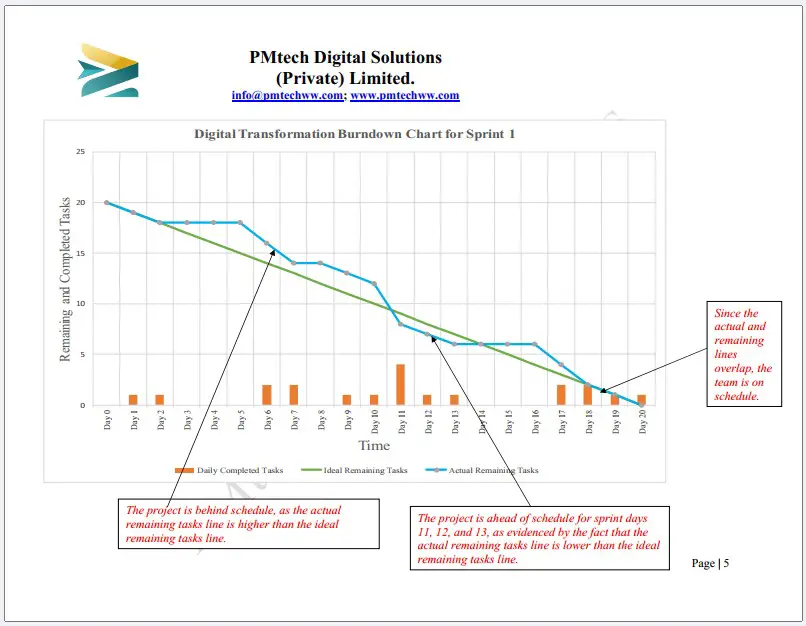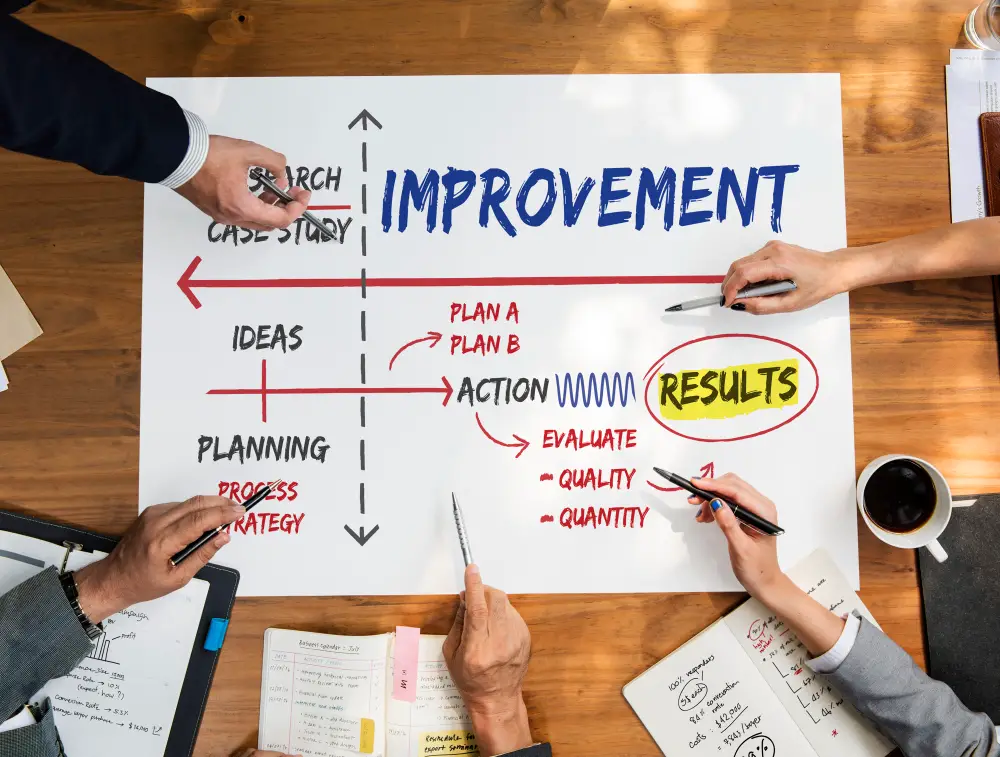In today’s Agile development world, tracking progress is essential. The Free agile burndown chart template is here to help. It’s a tool that boosts sprint planning for project managers, Agile teams, and Scrum masters.
These templates are vital. They range from simple to complex, like release and risk burndown charts. They show team progress and tasks left, making sprints better.
The templates show our overall work and when we might finish. They help us set goals for future sprints by looking at our current work.
For more information on burndown charts, check out these customizable templates.
Key Takeaways
- Agile burndown chart templates are indispensable for effective sprint planning.
- They offer real-time visualization of team progress and remaining tasks.
- Customizable templates cater to varied Agile project requirements, from simple to complex tracking needs.
- Burndown charts serve as predictive tools for future sprint planning by analyzing current progress.
- Integrating these charts into Agile methodologies facilitates improved team productivity and task management.
Introduction to Agile Burndown Charts
Agile Burndown Charts are crucial for managing projects. They show how fast tasks are completed against what’s left in a sprint. They’re great for seeing work visualization. This shows sprint progress and helps teams hit their targets on time.
Using a good Agile Burndown Chart Template is key. It lets project leaders and Scrum masters predict efforts needed for future releases. This makes sure we meet goals and satisfy clients. There are three types: sprint, release, and product charts. Each plays a unique role in managing projects.

Sprint burndown charts usually run for 1-4 weeks. They help teams see daily progress and check if they’re on track. Release burndown charts overview the progress of multiple sprints in a single release. They show how close we are to finishing user stories and epics.
Product burndown charts give a long-term view of the product backlog. They’re essential for making big decisions.
Burndown charts are about knowing the axes: the X-axis for time and the Y-axis for work left. Actual effort lines show progress per sprint or day, which can change for many reasons. Ideal effort lines show how work should progress in a perfect world.
Burndown charts are super useful for Agile teams in short sprints. They show what’s done, what’s left, and how much time is left. These charts help keep project updates fresh. They also spotlight issues before they get worse. We mainly see two types: the sprint burndown for work in each iteration, and the product burndown for the whole project’s work.
Keeping the Agile Burndown Chart Template up to date keeps teams on their toes. These charts not only show the current state. They also point out which tasks might not finish on time. This focus on upcoming risks ensures projects are managed well and finished successfully.
Key Features of an Agile Burndown Chart Template
An Agile burndown chart is a key tool in Agile development. It offers several features to help with task estimation and project tracking. It allows for real-time views of progress, giving updates on work left to do.

Task Tracking Capabilities
Task tracking is essential in project management, and an Agile burndown chart is vital for this. Teams can list tasks, categorize features, and note initial estimates. This lets team members keep an eye on work versus actual progress.
Project and product managers find burndown charts useful for tracking sprints. They help spot problems early and keep projects on track. Teams that regularly update and track their goals are more likely to meet them. Daily updates on burndown charts help manage unexpected changes and ensure tasks finish on time.
Customizable Options
Agile burndown charts offer customizable features. Teams can tailor charts to their needs. This includes changing time frames, altering effort graphs, and applying color codes for different statuses.
- Adjust time periods to fit specific sprint durations.
- Use color-coded indicators to highlight task statuses.
- Modify effort graphs to better represent team estimations.
Using a customizable Agile burndown chart can improve project management. It helps in setting clear goals, tracking progress, and celebrating achievements. This boosts the team’s morale and encourages a productive work environment.
Using Burndown Charts for Effective Sprint Planning
Agile burndown charts are key for Sprint Planning in Agile Development. They show work done and what’s left, offering a clear view. They also predict how a project will go, measuring progress during specific times. This helps manage sprints well in Scrum Methodology.

In stand-up meetings, these charts help check off completed tasks. They are simple and easy for all team members to get. They show progress and any differences, helping teams meet deadlines and budgets.
We often use tools like Jira for up-to-date burndown reports in Sprint Planning. It helps us spot and fix issues early, keeping the project on track.
Burndown charts track work done and highlight pending tasks. They give a peek at each sprint’s work and what’s left. Updating these charts daily keeps everyone aware and accountable. Agile Development values this clear communication for managing work and setting fair goals.
| Feature | Benefit | Function in Scrum |
|---|---|---|
| Visual Progress Tracking | Clear snapshot of work done vs. work needed | Helps in sprint evaluations and adjustments |
| Forecasting Tool | Predicts work completion timelines | Aids in planning future sprints efficiently |
| Daily Updates | Ensures real-time tracking of progress | Promotes consistent work pace and teams’ accountability |
We improve our burndown chart estimates using past data on team speed. Tools like Miro’s chart template adapt to different sprint lengths. This flexibility meets varied project needs.
Adding these methods to our Sprint Planning shows the real spirit of Agile Development and Scrum Methodology. It keeps teams ahead, open, and in control. This way, they smoothly move through sprints, aiming to reach project targets.
Advantages of Implementing Burndown Charts in Scrum Methodology
Using Burndown Charts in Scrum Methodology brings big benefits. They allow for tracking a project in real time and estimating tasks efficiently. These charts make the team’s progress clear, aiding in smart decision-making. Adjustments can be made as needed.

Enhanced Project Tracking
Burndown Charts are great for tracking projects fully. They show work left against time left. This way, teams see how they are doing fast. The quantity of story points a team completes informs how quickly they work.
For example, if a team finishes 30 story points and has 155 left, they need about six sprints to clear the backlog. This clear view helps everyone work together well. It makes sure all are working towards the same project aims.
Efficient Task Estimation
A big plus is better task estimation. Teams use past data to plan sprints smarter with Burndown Charts. By seeing planned against done tasks, they get better at predicting future work. Even when things don’t follow the perfect path, 72% of sprints still meet goals. This shows how valuable Burndown Charts are in Agile Development. They help set real goals and boost efficiency.
When paired with other tools, Burndown Charts get even stronger. Teams can look into their performance, see how the project moves along, plan budgets, and handle issues like too much work or guessing wrong. Burndown charts create a space for ongoing improvement and clear talks. They’re vital for anyone using Scrum Methodology.
How to Integrate Burndown Charts with Kanban Boards
Using an Agile Burndown Chart Template with Kanban Boards gives a full view of your team’s work. This mix improves the whole Agile Development process. Kanban boards show work flow well. Burndown charts track sprint progress closely.
Kanban boards show what’s being done with columns like “To Do,” “In Progress,” and “Completed.” This pairs well with the detailed progress an Agile Burndown Chart Template shows. Together, they offer both broad and detailed views of work. This helps teams make smart choices and quick changes.
Mixing these tools has a big plus. Burndown charts can spot issues faster than old ways. For example, if work finishes early, the burndown chart calculates the new finish date. It can also factor in non-work days.
Jira software is often the top choice for combining these tools. It lets teams set goals and track both short- and long-term projects. With daily chart updates, teams can see how they’re doing right away. This helps find and fix hold-ups fast.
Bringing burndown charts and Kanban boards together is great for software teams. It blends visual tasks with detailed tracking. This lets teams guess when they’ll finish work, share out tasks better, and stay on target. So, mixing these tools raises productivity and makes projects run smoother.

Best Practices for Using Agile Burndown Chart Templates
To get the most out of an Agile Burndown Chart Template, follow best practices. Keeping project tracking current is crucial. Reviewing team performance after sprints also enhances future work.
Regular Updates and Monitoring
Keep the Agile Burndown Chart Template fresh to see progress clearly. Project tracking becomes more effective this way. It also spots early issues and boosts team efficiency.
Users often miss features like burndown charts in their Agile tools. Such charts are key for tracking progress and understanding team metrics. They show if the team is behind or managing their daily tasks well.
Cumulative flow diagrams show how work moves through stages and finds hold-ups. Using Jira Software can help manage these charts better. It offers advanced tracking methods.
Conducting Sprint Retrospectives
At each sprint’s end, review the Sprint Retrospective. It’s vital for Agile Development. This examines the effort difference and boosts performance knowledge.
Teams look at burndown charts to get detailed project info. These charts have time on one axis and remaining work on the other. Such details are essential for evaluating a sprint’s success.
Applying these practices makes Agile Burndown Chart Templates more impactful. Updates and detailed sprint reviews refine project understanding. This sharpens resource and task planning.
Conclusion
Using an Agile Burndown Chart Template boosts our sprint planning and Agile development. It offers real-time insights and keeps projects on track. The visual comparison of finished tasks against what’s left motivates the team. It keeps everyone focused on project goals.
Adding them to Agile tools like Kanban boards increases their value. Creating charts with traditional tools such as Excel can be tough and prone to mistakes. By using platforms like Nifty or PMtech Digital Solutions, we make project management smoother and more cooperative. These sites offer better features than Excel. This includes improved data insights and real-time updates, which are key for accurate planning.
Adopting best practices ensures our teams do more than just hit their targets. Regular updates, monitoring, and detailed sprint retrospectives push our methods forward. They also secure project success and growth. The Agile Burndown Chart Template is essential, enhancing efficiency, openness, and teamwork in every sprint.
FAQ
What is an Agile Burndown Chart Template?
An Agile Burndown Chart Template visually shows sprint progress in Agile development. It compares finished tasks to what’s left to do. This helps project managers and Scrum masters follow project timelines. It also predicts the efforts needed for future sprints.
How do Agile Burndown Charts aid in Sprint Planning?
Agile burndown charts offer key data on how fast a team works and their task finishing rate. This allows for better sprint planning. Knowing past performance and tasks left helps teams set achievable goals. It also helps in assigning resources well for the next sprints.
What are the key features of an Agile Burndown Chart Template?
The main features include tracking many tasks, setting custom time periods, and seeing work left and done visually. Task names, initial bits estimated, and planned time lengths can be entered. Progress tracking uses colors and effort graphs that can be changed.
Why is regular updating of Burndown Charts important?
Updating the charts often keeps them true to the sprint’s current state. This lets teams decide smartly with the most current information. It tells everyone about progress and possible hold-ups. Quick changes can be made to ensure the sprint stays on path.
How can Burndown Charts and Kanban Boards be integrated?
Using burndown charts with Kanban boards gives a full picture of task status and progress. Burndown charts show work done against work left. Kanban Boards show task movement in detail. They work together to boost productivity and manage tasks better.
What is the role of Sprint Retrospectives in using Burndown Charts?
In sprint retrospectives, teams look over burndown charts after a sprint. They find differences between what they planned and actually did. This check helps spot improvement spots, get better at guessing task times, and plan sprints better for the next cycle.
What advantages do Burndown Charts bring to the Scrum methodology?
Burndown charts offer a clear view of sprint progress in real-time. They help in guessing tasks accurately by using past results. Teams can stay focused on their sprint aims, plan better, and meet what their organization and clients expect smoothly.

















43 Responses
Your point of view caught my eye and was very interesting. Thanks. I have a question for you.
If this workout feels too easy, you’re free to add an additional train. The different
advantage of the b2B program is all the additional content it
consists of. We’ll train you everything you
have to know to achieve 20 kilos in the next 20 weeks.
It comes with a full guarantee, and we have a full refund policy.
That stated, I know some folks advocate for short bulking phases as an alternative of a finest workout
plan for year-long constructing muscle. While shorter bulks may go
for some, they often lead to speedy fat achieve and the necessity
for fixed cutting. I think committing to a year-long bulking exercise plan for
newbies or advanced lifters is simpler. It allows for regular muscle development without the drastic yo-yo results of
frequent bulking and chopping.
If you solely do one exercise on your biceps, this classic movement should
be it. The barbell curl fixes your forearms in a supinated position, producing a
robust biceps contraction. Meanwhile, the two-handed action means you can use plenty of strength-building weight.
I’ve spent the final three many years testing the effectiveness of tons of of various workout
routines. Throughout this lifelong journey, I have found what I consider are
the best exercises for constructing strong, sculpted arms.
There is a huge distinction in consuming extra calories than your upkeep stage and consuming less.
Your physique is good at overeating and responds well to it.
It’s possible to bulk without getting fats, particularly for newbies.
There’s no worth in altering them just yet… so
persist with them and see how a lot you’ve improved since week 2.
On set one, the weight you select might let you perform thirteen good reps to fatigue.
But when you come back for the subsequent set, you solely manage 9.
That’s fantastic – as lengthy as you’re inside your rep range you’re doing great.
This sort of approach results in big will increase in muscle
mass, but as a outcome of the calorie surplus is so excessive,
it might possibly additionally result in fat mass.
However there’s nothing wrong with easing back on cardio for a number of months.
Cardio is nice whereas bulking, but it isn’t necessary.
Hard-gainers or ectomorphs imagine it’s troublesome for them to build muscle
due to genetics.
Your finish goal is building muscle, in any case, not getting fat.
While both a dirty bulk and a clean bulk will let you
pack on muscle mass, a clear bulk is obviously the only option because it comes with significantly much less fat positive aspects.
All in all, the extra advanced you get, the tougher
it’ll be to gain muscle. An superior lifter can, AT ABSOLUTE BEST, anticipate 0.25% to 0.5% of their
whole bodyweight acquire as fat-free muscle per 30 days.
This means if you are close to your genetic potential, you
may find a way to placed on 2-3lbs of lean muscle in a yr.
The additional you’re from your genetic potential, the extra you’ll have
the ability to acquire. So, again, it’s exhausting to answer
this question as it’s all on the individual.
If you need to learn how to lift weights, build muscle,
and get stronger, I advocate beginning with our article about how
to get stronger at the 5 huge compound workouts. “You must really feel it working, so if it’s too simple you’ll be able to add weight with something heavy enough,” continues Crockford.
“These are a mix of standard units and supersets to construct muscle, however with moderately brief relaxation durations to additionally hold the center rate up to burn fats too.”
Even expertly-designed exercise plans don’t work without motivation and effort.
You’ll be managing both food regimen and training with a double-barrel shotgun method.
We want to give you the opportunity to carve out one thing you haven’t had shortly – a physique that you could
be pleased with.
If you’re doing all your urgent in a power cage, you’ll have a
pull-up bar helpful. Dips and dumbbell curls could be supersetted collectively,
too. Forearm curls are a discretionary lift you can exchange.
Press Day is built around an overhead press variation. If
you’re especially keen to construct an enormous bench press, you
could even do a close-grip bench press here.
The underlying idea is that rigorously coaching a muscle
stimulates 2–3 days of progress.
This is nice news for residence exercisers who don’t normally have access to the weights and machines that gym-goers
typically take as a right. So, whether you practice in your
bed room or a state-of-the-art health facility, you’ll have the ability to nonetheless build the triceps of
your goals. For six months previous to filming, Graham committed to
5 power training exercises (each lasting not more than an hour) and three boxing sessions
per week. Alan Ritchson trains 5 instances every week and
takes his relaxation seriously. He also mentions utilizing a sauna for restoration after coaching.
Saunas can improve blood circulate to the muscle tissue,
serving to to hasten recovery and therapeutic.
Utilizing a meals journal, meals scale, and a meal planning app of some type are necessities for maximizing your muscle development when bulking.
On the other hand, if you’re struggling to placed on weight,
adding excessive cardio to your bulking routine makes it even more durable.
Most individuals who wrestle to realize weight and muscle on keto
don’t eat sufficient as a result of their food plan is so filling.
I superset them with neck curls, however you can superset them with any small isolation train. I like the entrance squat here as a end
result of it challenges our quads, glutes, and spinal erectors, making
it an excellent assistance train for the deadlift.
If you’re squatting in a squat rack, you’ll have a pull-up bar
handy, permitting you to superset leg raises.
Not to say, if they are taking efficiency enhancement medicine, as that fully changes issues.
It’s sometimes finest to purpose for zero.5-1lb of lean muscle
gain per week as this will enable for less fat acquire. The slower and cleaner your bulk (i.e.
aim to achieve zero.5-1lb of muscle per week), the higher.
By doing this, you won’t have to fret about your physique fats share
skyrocketing. It helps you meet your protein targets with out
a lot trouble. This interprets to an additional 200 to
500 energy per day.
The dumbbell bench press is one other great carry on your chest.
It’s a compound raise, nevertheless it does a greater job of emphasizing the pecs.
It’s also nice for getting a deep stretch in your
pecs on the backside of the range of motion, which is
unbelievable for building muscle. You’ll again employ
a reverse pyramid scheme of reps, though in Week 2
you’ll go barely higher in reps (15) in your third
set of each exercise. You’ll start this system
with a full-body coaching break up, that means you’ll train all major bodyparts in every workout (as opposed to “splitting up” your training).
Prepare three days this primary week, performing only one exercise per
bodypart in every session. The leg press allows you to use heavy loads in comparison with the squat, but you’re not in the health club to maneuver as a lot weight as
possible.
This is as a result of you should be coming off a rest
day before every single workout! Too often, trainees try to go to the health club and
kill it each exercise. Restoration is amongst the most essential components of an effective program, and a full
body workout plan ensures you don’t overtrain.
Utilizing a full physique workout is a highly efficient approach to
train, but that’s not its solely benefit.
You’ll present as a lot as Monday’s workout feeling stronger
and more energizing. Bodybuilders and lifters love and hate Bulgarian split squats.
They work your quads and glutes via an prolonged range of movement and torches just
about all muscle fibers in your legs. So, whereas the 6-day workout may be
productive, it’s unimaginable to say how quickly you’ll
begin to see results. It might be a number of weeks, nevertheless it could additionally be
a few months.
If you notice fast weight acquire, it could be time
to adjust your food regimen. Think About implementing upkeep weeks
or light mini-cuts if needed. Getting your
macros proper is crucial for muscle development throughout
a bulk. The stability between protein, carbohydrates, and fats can make or break your progress.
Monitoring your progress is essential during a year-long
bulk. With Out monitoring, it is easy to lose sight of your goals.
This transformation required a devoted fitness center routine, a disciplined workout plan, and a revamped
food regimen. Below, we cowl Alan Ritchson’s exercise and
food regimen for Reacher. In this program, you’ll perform every exercise as soon as
per week and take three days off every week (for instance, raise on Monday, Tuesday, Thursday and Friday).
Use this six-week coaching plan as quickly as, or repeat it—it’s constructed
for results each within the short time period and over the long
haul. Creatine allows you to lift heavier weights and do more
reps, which can result in muscle development. It additionally helps increase muscle cell hydration, pulling water into your
muscular tissues and making them look fuller and greater.
High-intensity power training, along with plenty of good meals and enough rest and restoration, is the way to add high quality mass to
your frame.
Given what quantity of profitable bodybuilders have used
this training approach, it’s safe to say that the bro cut up can be
effective. However, it will not be best for natural lifters and anybody other than genetically gifted mesomorphic straightforward gainers.
For example, suppose you can only practice 2-3 instances per week.
In that case, a full-body workout will probably be finest, whether you are a newbie or an Olympic athlete.
Relaxation is a crucial aspect of constructing a robust physique.
The physique wants time to recuperate and recover from the stress of intense coaching.
Alan Ritchson’s tall body is completely capped with a pair of boulder shoulders.
As Soon As once more, Ritchson doesn’t focus solely on the mirror muscle tissue like anterior and lateral deltoids.
As A Substitute, he focuses on developing all three heads equally and
contains posterior deltoid workout routines in the shoulder coaching session as nicely.
Once More, here’s your reminder to hit your protein objectives, get enough rest, and let your
muscles rest and restore. Start Chris Bumstead’s workout routine with
rope press downs earlier than shifting to incline
dumbbell skull crushers.
Individuals who prepare too incessantly find yourself getting
burned out and so they do not even notice it.
4 days of exercises per week is often the candy spot in relation to health.
Over the course of the six months, Graham’s coaching followed a formulation which may sound familiar to bodybuilding fans.
Put Together to maximise your positive aspects with our exclusive
12-week hypertrophy training program. Choose between a four or 5
day coaching cut up and gain 2-12 kilos of muscle over 90
days… If you’ve been lifting for some time, you will want to “bulk” to achieve muscle.
References:
Tren Steroid Side Effects
Anavar drugs are commonly utilized by people to heal sure accidents and wounds (5)
faster than simple rest alone. Moreover, docs typically prescribe Anavar and
administer cortisone injections to assist heal their patients.
So should you’ve obtained an old weight-lifting or
sports activities injury that also is not fairly right, contemplate some var.
In addition to talking along with your healthcare supplier,
there are some things you can do at residence to handle your side effects.
Right Now, Anavar is illegal for leisure use in almost each country on the earth, except Mexico,
where it may be purchased at an area pharmacy. DHT (dihydrotestosterone) is a powerful androgen that binds to hair
follicles on the scalp, leading to miniaturization and inhibited growth.
Approximately a decade after Anavar came on the market, there was promise
of it being a medicine to efficiently treat excessive ldl cholesterol.
This was because of doctors in the ’70s observing decreased total cholesterol levels in Anavar users (15).
Some Anavar customers report massive pumps, often in the decrease back, which could be
uncomfortable or painful.
Nonetheless, as of the writing of this text, higher doses of the drug (useful for treating burn victims) remain legal.
Moreover, it has been reported to have a constructive impression on recovery.
By reducing muscle harm and inflammation, it might help people bounce back extra rapidly
from intense training classes or competitions.
This can additional contribute to improved stamina and decreased fatigue, enabling athletes to take care of consistency
of their training routines and obtain higher overall outcomes.
This should include high-quality protein and carbs (not refined or white carbohydrates).
Very little Oxandrolone is produced for human medical use these days, so there’s hardly any supply of pharma-grade merchandise.
That means it won’t be low cost if yow will discover some (and be sure it’s reliable and genuine).
By taking these steps, you’ll have the ability to be certain that your Anavar stays effective and
protected to make use of. Nonetheless, like several medicine, Anavar has an expiration date,
and taking expired treatment could be dangerous to your health.
” and offer you all the data you have to find out about Anavar’s shelf life and how to retailer it properly. For the male athlete in his bulking season the Oxandrolone hormone is generally reasoned to be a poor choice as it is not well-suited for large buildups in mass. Make no mistake; it could possibly construct lean tissue simply not to any vital degree. Anavar given to healthy men, has been shown to extend protein synthesis by as much as 44% and enhance results of resistance coaching. Utilizing expired Anavar could be harmful because the efficiency and effectiveness of the medication might decrease over time, making it less efficient or unpredictable.
For these greater and more extended doses, Anavar for ladies use at this advanced stage would typically be to potentiate their ends in bodybuilding among those that are more experienced. Switching back to Anavar for men, these cycles get very costly for a man who’s primarily counting on var for positive aspects; males will take upwards of 80mg-100mg for an Anavar solely cycle. Including to the Anavar women subject, this drug is nice for feminine athletes in search of an edge. Contemplating the wonderful strength and muscle positive aspects that var provides to women, athletes will really respect it. Unfortunately, collegiate and skilled sports leagues do not exactly endorse Anavar for women, so taking it’s certainly dangerous for drug-tested athletes.
Nevertheless, navigating the uncharted waters of the black market entails a myriad of dangers and risks that warrant cautious consideration. For occasion, you might take Anavar for eight weeks and then take a break for four weeks. This will assist to forestall your body from turning into tolerant to the treatment.
However overuse of anabolic steroids can cause a painful or prolonged erection [10]. And that’s additionally positively not a great thing to happen when you’re making an attempt to focus in your squats or standing in a queue at Starbucks. Anvarol is produced utilizing natural components which might be designed to simulate the effects of Anavar without so many antagonistic reactions. It is a a lot safer method to shed pounds and add definition to your muscle mass than Anavar. Anavar is considered an anabolic steroid by the World Anti-Doping Affiliation and is, subsequently, banned for aggressive functions.
While it could contribute to bulking with high-quality weight gain6 without water retention, Anavar is strongest for chopping and enhancing athletic efficiency. Girls who use Anavar will, nevertheless, find that it may possibly add impressive lean muscle positive aspects to the physique, and that is the main anabolic steroid that’s suitable for girls to make use of for this purpose. Anavar (Oxandrolone) holds a particular place on the earth of anabolic steroids for its suitability and relatively gentle nature for female users. It has gained reputation amongst ladies seeking performance enhancement, physique recomposition, or athletic enchancment. Anavar’s low androgenic properties make it less prone to trigger virilization, a set of masculinizing unwanted side effects.
Another examine revealed that men aged years old additionally skilled a significant amount of Anavar weight reduction (4). Anavar is highly reviewed among othe efficiency enhancing supplements. This is likely one of the most typical anabolic steroids used to combat muscle losing ailments and in some cases even osteoporosis, while used to advertise lean tissue positive aspects.
Please note that particular person outcomes could range, and it is essential to make use of Anavar responsibly and beneath skilled steering. First, it permits for a synergistic effect, the place the combined compounds work together to provide extra pronounced results compared to using Anavar alone. Stacking also can assist individuals tailor their cycles to their specific targets, whether it’s gaining muscle mass, slicing fat, or enhancing athletic performance. Moreover, by strategically combining compounds, customers could possibly achieve their desired results extra efficiently and effectively, making probably the most out of their Anavar cycle. Anavar, also referred to as Oxandrolone, exerts its effects in the body through a number of mechanisms. One of its primary actions is its anabolic effect, which reinforces protein synthesis.
It additionally means you’ll probably wish to break up your daily dosage into two administrations to maintain optimal blood levels. Nevertheless, it’s possible to maintain a once-daily dosage schedule with no unfavorable issues. As expected, most reviews and experiences from actual individuals utilizing Anavar are optimistic. Individuals report excellent results for weight reduction, cutting, and preserving muscle tissue, which is the place Anavar excels. Anavar is particularly good at eliminating fats in additional cussed areas, and for ladies, this is usually across the thighs and buttocks.
References:
Best pill steroids (https://ignitionadvertising.com)
Hi there very cool website!! Guy .. Excellent .. Amazing .. I’ll bookmark your web site and take the feeds alsoKI am glad to search out numerous helpful info right here within the put up, we need work out extra strategies on this regard, thank you for sharing. . . . . .
What’s Happening i am new to this, I stumbled upon this I’ve found It positively helpful and it has helped me out loads. I hope to give a contribution & assist different customers like its helped me. Great job.
Good day! I could have sworn I’ve been to your blog before
but after browsing through a few of the posts I realized it’s new to me.
Anyways, I’m certainly pleased I came across it and I’ll
be bookmarking it and checking back regularly!
My blog nordvpn coupons inspiresensation
Nordvpn Cashback 350fairfax
Outstanding story there. What happened after? Good luck!
I don’t think the title of your article matches the content lol. Just kidding, mainly because I had some doubts after reading the article.
70918248
References:
the best cutting steroid
Wow! Thank you! I continually needed to write on my blog something like that. Can I take a part of your post to my site?
I’ve recently started a blog, the information you provide on this website has helped me greatly. Thank you for all of your time & work. “If you see a snake, just kill it. Don’t appoint a committee on snakes.” by H. Ross Perot.
70918248
References:
anabolic steroids pictures, digitalboda.co.Ke,
70918248
References:
none (Tammie)
70918248
References:
none – https://kudbiser.com/ –
Este site é realmente fabuloso. Sempre que consigo acessar eu encontro coisas incríveis Você também vai querer acessar o nosso site e descobrir detalhes! Conteúdo exclusivo. Venha descobrir mais agora! 🙂
Today, I went to the beach front with my children. I found a sea shell and
gave it to my 4 year old daughter and said “You can hear the ocean if you put this to your ear.” She placed the shell
to her ear and screamed. There was a hermit crab inside and it pinched her ear.
She never wants to go back! LoL I know this is completely off topic but
I had to tell someone!
Have a look at my site Eharmony Special Coupon Code 2025
Pretty nice post. I just stumbled upon your weblog and wanted to say that I have really enjoyed surfing around your blog posts. After all I’ll be subscribing to your rss feed and I hope you write again soon!
Your article helped me a lot, is there any more related content? Thanks!
It’s going to be finish of mine day, but before finish I
am reading this great article to improve my experience.
My web-site; vpn
I?¦ll immediately grasp your rss as I can’t in finding your email subscription hyperlink or newsletter service. Do you have any? Kindly allow me know so that I may just subscribe. Thanks.
Nice post. I learn something totally new and challenging on websites
You’re so awesome! I don’t believe I have read a single thing like that before. So great to find someone with some original thoughts on this topic. Really.. thank you for starting this up. This website is something that is needed on the internet, someone with a little originality!
Hi there, You’ve done an excellent job. I’ll certainly digg it and personally recommend to
my friends. I am sure they’ll be benefited from this web
site. https://tinyurl.com/2cab6g88 gamefly
For the reason that the admin of this site is working, no uncertainty very quickly it will be renowned, due to its quality contents.
Hi there to all, for the reason that I am genuinely keen of reading this website’s post to be updated on a regular basis. It carries pleasant stuff.
Wow! After all I got a webpage from where I know how to actually get valuable information concerning
my study and knowledge. https://tinyurl.com/2xsenm6a what does
a vpn do
Nice weblog here! Additionally your website rather a lot up fast!
What host are you the usage of? Can I get your associate hyperlink on your host?
I want my site loaded up as fast as yours lol
Greetings from Colorado! I’m bored to tears at work so I decided to browse your
site on my iphone during lunch break. I love the knowledge you present here and
can’t wait to take a look when I get home. I’m amazed at
how quick your blog loaded on my mobile .. I’m not even using
WIFI, just 3G .. Anyways, excellent site!
Perfect work you have done, this internet site is really cool with superb information.
You really make it appear really easy along with your presentation but I to find this topic to be actually something that I believe I would by no means understand. It sort of feels too complicated and very wide for me. I’m looking ahead in your next put up, I?¦ll try to get the cling of it!
Those are yours alright! . We at least need to get these people stealing images to start blogging! They probably just did a image search and grabbed them. They look good though!
Glad to be one of several visitors on this awe inspiring website : D.
I’ve been exploring for a little bit for any high quality articles or blog posts on this kind of area . Exploring in Yahoo I eventually stumbled upon this web site. Reading this information So i’m satisfied to express that I have a very just right uncanny feeling I discovered exactly what I needed. I so much unquestionably will make certain to do not fail to remember this website and give it a look regularly.
You have mentioned very interesting details! ps decent site. “The length of a film should be directly related to the endurance of the human bladder.” by Alfred Hitchcock.
It’s amazing in support of me to have a site, which is good in support of my experience.
thanks admin https://tinyurl.com/yvodnsan eharmony special coupon code 2025
I don’t think the title of your article matches the content lol. Just kidding, mainly because I had some doubts after reading the article.
I enjoy what you guys tend to be up too. This sort of clever work
and reporting! Keep up the superb works guys I’ve you guys to my
blogroll.
Take a look at my homepage https://tinyurl.com/2z8a8z72
purchase ipamorelin effects
References:
independent.academia.edu
Have you ever thought about adding a little bit more than just your articles? I mean, what you say is valuable and everything. But think of if you added some great visuals or videos to give your posts more, “pop”! Your content is excellent but with pics and clips, this website could definitely be one of the very best in its niche. Fantastic blog!
Thank you for your sharing. I am worried that I lack creative ideas. It is your article that makes me full of hope. Thank you. But, I have a question, can you help me?
An attention-grabbing discussion is price comment. I feel that you need to write more on this subject, it might not be a taboo topic but typically people are not enough to speak on such topics. To the next. Cheers
what do anabolic steroids do to the body
References:
http://git.huixuebang.com
An impressive share, I just given this onto a colleague who was doing a little analysis on this. And he in fact bought me breakfast because I found it for him.. smile. So let me reword that: Thnx for the treat! But yeah Thnkx for spending the time to discuss this, I feel strongly about it and love reading more on this topic. If possible, as you become expertise, would you mind updating your blog with more details? It is highly helpful for me. Big thumb up for this blog post!